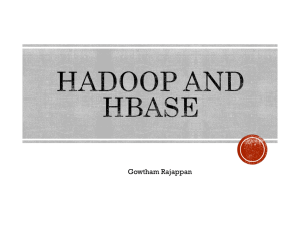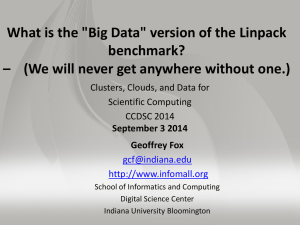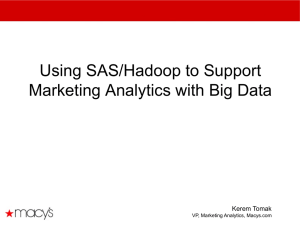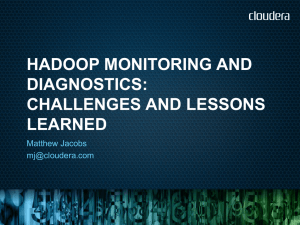PPT - Big Data Open Source Software and Projects
advertisement
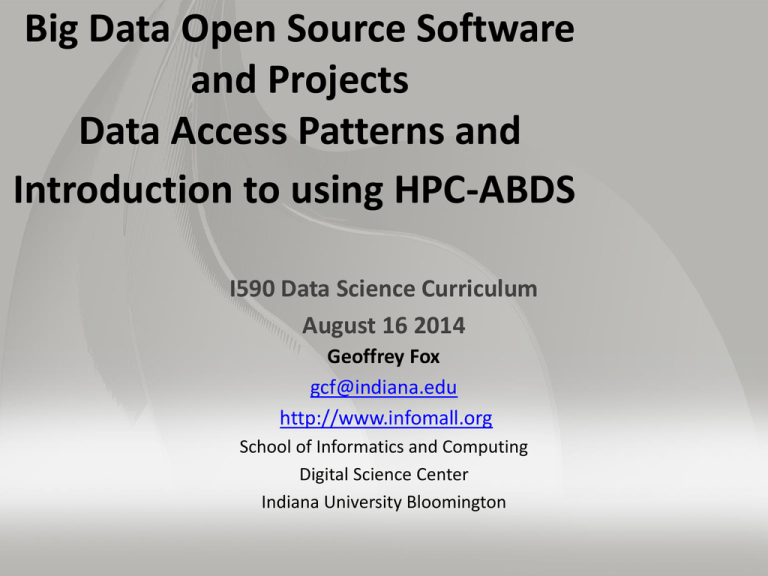
Big Data Open Source Software and Projects Data Access Patterns and Introduction to using HPC-ABDS I590 Data Science Curriculum August 16 2014 Geoffrey Fox gcf@indiana.edu http://www.infomall.org School of Informatics and Computing Digital Science Center Indiana University Bloomington HPC-ABDS • • • • HPC-ABDS ~120 Capabilities >40 Apache Green layers have strong HPC Integration opportunities • Goal • Functionality of ABDS • Performance of HPC Kaleidoscope of (Apache) Big Data Stack (ABDS) and HPC Technologies Cross-Cutting Functionalities Message Protocols: Thrift, Protobuf Distributed Coordination: Zookeeper, Giraffe, JGroups Security & Privacy: InCommon, OpenStack Keystone, LDAP, Sentry Monitoring: Ambari, Ganglia, Nagios, Inca Workflow-Orchestration: Oozie, ODE, Airavata, OODT (Tools), Pegasus, Kepler, Swift, Taverna, Trident, ActiveBPEL, BioKepler, Galaxy, IPython Application and Analytics: Mahout , MLlib , MLbase, CompLearn, R, Bioconductor, ImageJ, Scalapack, PetSc High level Programming: Hive, HCatalog, Pig, Shark, MRQL, Impala, Sawzall, Drill Basic Programming model and runtime, SPMD, Streaming, MapReduce: Hadoop, Spark, Twister, Stratosphere, Tez, Llama, Hama, Storm, S4, Samza, Giraph, Pregel, Pegasus, Reef Inter process communication Collectives, point-to-point, publish-subscribe: Harp, MPI, Netty, ZeroMQ, ActiveMQ, RabbitMQ, QPid, Kafka, Kestrel In-memory databases/caches: GORA (general object from NoSQL), Memcached, Redis (key value), Hazelcast, Ehcache Object-relational mapping: Hibernate, OpenJPA and JDBC Standard Extraction Tools: UIMA, Tika SQL: Oracle, MySQL, Phoenix, SciDB, Apache Derby NoSQL: HBase, Accumulo, Cassandra, Solandra, MongoDB, CouchDB, Lucene, Solr, Berkeley DB, Azure Table, Dynamo, Riak, Voldemort. Neo4J, Yarcdata, Jena, Sesame, AllegroGraph, RYA, Parquet File management: iRODS Data Transport: BitTorrent, HTTP, FTP, SSH, Globus Online (GridFTP) Cluster Resource Management: Mesos, Yarn, Helix, Llama, Condor, SGE, OpenPBS, Moab, Slurm, Torque File systems: HDFS, Swift, Cinder, Ceph, FUSE, Gluster, Lustre, GPFS, GFFS Interoperability: Whirr, JClouds, OCCI, CDMI DevOps: Docker, Puppet, Chef, Ansible, Boto, Libcloud, Cobbler, CloudMesh IaaS Management from HPC to hypervisors: OpenStack, OpenNebula, Eucalyptus, CloudStack, vCloud, Amazon, Azure, Google TYPICAL DATA INTERACTION SCENARIOS These consist of multiple data systems including classic DB, streaming, archives, Hive, analytics, workflow and different user interfaces (events to visualization) From Bob Marcus (ET Strategies) http://bigdatawg.nist.gov/_uploadfiles/M0311_v2_2965963213.pdf We list 10 and then go through each (of 10) in more detail. These slides are based on those produced by Bob Marcus at link above 10 Generic Data Processing Use Cases 1) Multiple users performing interactive queries and updates on a database with basic availability and eventual consistency (BASE = (Basically Available, Soft state, Eventual consistency) as opposed to ACID = (Atomicity, Consistency, Isolation, Durability) ) 2) Perform real time analytics on data source streams and notify users when specified events occur 3) Move data from external data sources into a highly horizontally scalable data store, transform it using highly horizontally scalable processing (e.g. Map-Reduce), and return it to the horizontally scalable data store (ELT Extract Load Transform) 4) Perform batch analytics on the data in a highly horizontally scalable data store using highly horizontally scalable processing (e.g MapReduce) with a user-friendly interface (e.g. SQL like) 5) Perform interactive analytics on data in analytics-optimized database 6) Visualize data extracted from horizontally scalable Big Data store 7) Move data from a highly horizontally scalable data store into a traditional Enterprise Data Warehouse (EDW) 8) Extract, process, and move data from data stores to archives 9) Combine data from Cloud databases and on premise data stores for analytics, data mining, and/or machine learning 10) Orchestrate multiple sequential and parallel data transformations and/or analytic processing using a workflow manager 1. Multiple users performing interactive queries and updates on a database with basic availability and eventual consistency Generate a SQL Query Process SQL Query (RDBMS Engine, Hive, Hadoop, Drill) Data Storage: RDBMS, HDFS, Hbase Data, Streaming, Batch ….. Includes access to traditional ACID database 2. Perform real time analytics on data source streams and notify users when specified events occur Specify filter Filter Identifying Events Streaming Data Streaming Data Post Selected Events Fetch streamed Data Posted Data Streaming Data Identified Events Archive Repository Storm, Kafka, Hbase, Zookeeper 3. Move data from external data sources into a highly horizontally scalable data store, transform it using highly horizontally scalable processing (e.g. Map-Reduce), and return it to the horizontally scalable data store (ELT) Transform with Hadoop, Spark, Giraph … Data Storage: HDFS, Hbase Streaming Data Web Services OLTP Database ETL is Extract Load Transform http://www.dzone.com/articles/hadoop-t-etl 4. Perform batch analytics on the data in a highly horizontally scalable data store using highly horizontally scalable processing (e.g MapReduce) with a user-friendly interface (e.g. SQL like) SQL Query HCatalog Hive General Analytics Mahout, R Hadoop, Spark, Giraph, Pig … Data Storage: HDFS, Hbase Data, Streaming, Batch ….. Hive Example • http://venublog.com/2013/07/16/ha doop-summit-2013-hiveauthorization/ 5. Perform interactive analytics on data in analytics-optimized database Similar to 4 which is batch Mahout, R Hadoop, Spark, Giraph, Pig … Data Storage: HDFS, Hbase Data, Streaming, Batch ….. SCIENCE EXAMPLES 5A. Perform interactive analytics on observational scientific data Science Analysis Code, Mahout, R Grid or Many Task Software, Hadoop, Spark, Giraph, Pig … Data Storage: HDFS, Hbase, File Collection Direct Transfer Streaming Twitter data for Social Networking Record Scientific Data in “field” Transport batch of data to primary analysis data system Local Accumulate and initial computing Following examples are LHC, Remote Sensing, Astronomy and Bioinformatics Particle Physics (LHC) LHC Data analyzes ~30 petabytes of data per year produced at CERN using ~300,000 cores around the world Data reduced in size, replicated and looked at by physicists Astronomy – Dark Energy Survey I Victor M. Blanco Telescope Chile where new wide angle 520 mega pixel camera DECam installed https://indico.cern.ch/event/214784/ session/5/contribution/410 Ends up as part of International Virtual observatory (IVOA), which is a collection of interoperating data archives and software tools which utilize the internet to form a scientific research environment in which astronomical research programs can be conducted. Astronomy – Dark Energy Survey II For DES (Dark Energy Survey) the data are sent from the mountaintop via a microwave link to La Serena, Chile. From there, an optical link forwards them to the NCSA (UIUC) as well as NERSC (LBNL) for storage and "reduction”. Here galaxies and stars in both the individual and stacked images are identified, catalogued, and finally their properties measured and stored in a database. DES Machine room at NCSA Astronomy Hubble Space Telescope HST Processing in Baltimore Md http://asd.gsfc.nasa.gov/archive/hubble/a_pdf/news/facts/FS14.pdf CReSIS Remote Sensing: Radar Surveys Expeditions last 1-2 months and gather up to 100 TB data. Most is saved on removable disks and flown back to continental US at end. A sample is analyzed in field to check instrument Gene Sequencing Distributed (Illumina) devices distributed across world in many laboratories take data in form of “reads” that are aligned into a full sequence This processing often local but data needs to be compared with world’s other gene so uploaded to central repository Illumina HiSeq X 10 can sequence 18,000 genomes per year at $1000 each. Produces 0.6Terabases per day REMAINING GENERAL ACCESS PATTERNS 6. Visualize data extracted from horizontally scalable Big Data store Interactive Visualization Specify Analytics Orchestration Layer Prepare Interactive Visualization Hadoop, Spark, Giraph, Pig … Data Storage: HDFS, Hbase Mahout, R 7. Move data from a highly horizontally scalable data store into a traditional Enterprise Data Warehouse Data Warehouse Query Transform with Hadoop, Spark, Giraph … Data Storage: HDFS, Hbase, (RDBMS) Streaming Data Web Services OLTP Database Moving to EDW Example from Teradata Moving data from HDFS to Teradata Data Warehouse and Aster Discovery Platform http://blogs.teradata.com/data-points/announcing-teradata-aster-big-analytics-appliance/ 8. Extract, process, and move data from data stores to archives Transform as needed Transform with Hive, Drill, Hadoop, Spark, Giraph, Pig … Archive Data Storage: HDFS, Hbase, RDBMS Streaming Data Web Services OLTP Database ETL is Extract Load Transform http://www.dzone.com/articles/hadoop-t-etl 9. Combine data from Cloud databases and on premise data stores for analytics, data mining, and/or machine learning Mahout, R Hadoop, Spark, Giraph, Pig … Data Storage: HDFS, Hbase On premise Data Streaming Data Similar to 4 and 5 http://wikibon.org/w/images/2/20/Cloud-BigData.png Example: Integrate Cloud and local data 10. Orchestrate multiple sequential and parallel data transformations and/or analytic processing using a workflow manager This can be used for science by adding data staging phases as in case 5A Specify Analytics Pipeline Orchestration Layer (Workflow) Analytic-3 (Visualize) Analytic-2 Hadoop, Spark, Giraph, Pig … Data Storage: HDFS, Hbase Analytic-1 Example from Hortonworks http://hortonworks.com/hadoop/yarn/ USING THE HPC-ABDS STACK Typical Usage Model of HPC-ABDS Layers 1) 2) 3) 4) 5) 6) 7) 8) 9) 10) 11) 12) 13) 14) 15) 16) 17) Message Protocols Distributed Coordination: Security & Privacy: Monitoring: IaaS Management from HPC to hypervisors: DevOps: Here are 17 functionalities. Lets discuss how Interoperability these are used in particular applications File systems: 4 Cross cutting at top Cluster Resource Management: 12 in order of layered diagram starting at Data Transport: bottom SQL / NoSQL / File management: In-memory databases&caches / Object-relational mapping / Extraction Tools Inter process communication Collectives, point-to-point, publish-subscribe Basic Programming model and runtime, SPMD, Streaming, MapReduce, MPI: High level Programming: Application and Analytics: Workflow-Orchestration: Using HPC-ABDS Layers I 1) Message Protocols This layer is unlikely to seen in many applications as used in “underlying system”. Thrift and Protobuf have similar functionality and are used to build messaging protocols between components (services) of system 2) Distributed Coordination Zookeeper is likely to be used in many applications as it is way that one achieves consistency in distributed systems – especially in overall control logic and metadata. It is for example used in Apache Storm to coordinate distributed streaming data input with multiple servers ingesting data from multiple sensors. JGroups is less commonly used and is very different. It builds secure multi-cast messaging with a variety of transport mechanisms. 3) Security & Privacy I This is of course a huge area present implicitly or explicitly in all applications. It covers authentication and authorization of users and the security of running systems. In the Internet there are many authentication systems with sites often allowing you to use Facebook, Microsoft , Google etc. credentials. InCommon, operated by Internet2, federates research and higher education institutions, in the United States with identity management and related services. Using HPC-ABDS Layers II 3) Security & Privacy II LDAP is a simple database (key-value) forming a set of distributed directories recording properties of users and resources according to X.500 standard. It allows secure management of systems. OpenStack Keystone is a role-based authorization and authentication environment to be used in OpenStack private clouds. 4) Monitoring: Here Ambari is aimed at installing and monitoring Hadoop systems. Nagios and Ganglia are similar system monitors with ability to gather metrics and produce alerts. Inca is a higher level system allowing user reporting of performance of any sub system. Essentially all systems use monitoring but most users do not add custom reporting. 5) IaaS Management from HPC to hypervisors: These technologies underlie all your applications. The classic technology OpenStack manages virtual machines and associated capabilities such as storage and networking. The commercial clouds have their own solution and it is possible to move machine images between these different environments. As a special case there is “bare-metal” i.e. the null hypervisor. Using HPC-ABDS Layers III 6) DevOps This describes technologies and approaches that automate the deployment and installation of software systems and underlies “software-defined systems”. We will integrate tools together in Cloudmesh – Libcloud, Cobbler, Chef, Docker, Slurm, Ansible, Puppet. Celery. Everybody will use this 7) Interoperability This is both standards and interoperability libraries for services (Whirr), compute (OCCI), virtualization and storage (CDMI) 8) File systems You will use files in any application but the details may not be visible to application. Maybe you interact with data at level of a data management system or an Object store (OpenStack Swift or Amazon S3). Most science applications are organized around files; commercial systems at a higher level. 9) Cluster Resource Management You will certainly need cluster management in your application although often this is provided by the system and not explicit to the user. Yarn from Hadoop is gaining in popularity while Slurm is a basic HPC system as are Moab, SGE, OpenPBS and Condor also well known for scheduling of Grid applications. Mesos is similar to Yarn but appears less mature at present. Using HPC-ABDS Layers IV 10) Data Transport Globus Online or GridFTP is dominant system in HPC community but this area is often not highlighted as often application only starts after data has made its way to disk of system to be used. Simple HTTP protocols are used for small data transfers while the largest ones use the “Fedex/UPS” solution of transporting disks between sites. 11) SQL / NoSQL / File management This is a critical area for nearly all applications as it captures areas of file, object, NoSQL and SQL data management. The many entries in area testify to variety of problems (graphs, tables, documents, objects) and importance of efficient solution. Just a little while ago, this area was dominated by SQL databases and file managers. 12) In-memory databases&caches / Object-relational mapping / Extraction Tools This is another important area addressing two points. Firstly conversion of data between formats and secondly enabling caching to put as much processing as possible in memory. This is an important optimization with Gartner highlighting this areas in several recent hype charts with In-Memory DBMS and In-Memory Analytics. Using HPC-ABDS Layers V 13) Inter process communication Collectives, point-to-point, publish-subscribe This describes the different communication models used by the systems in layers 13, 14) below. Your results may be very sensitive to choices here as there are big differences from disk-based versus point to point for Hadoop v. Harp or the different latencies exhibited by publish-subscribe systems. Your results will reflect higher level system chosen 14) Basic Programming model and runtime, SPMD, Streaming, MapReduce, MPI A very important layer defining the cloud (HPC-ABDS) programming model. Includes Hadoop and related tools Spark, Twister, Stratosphere, Hama (iterative MapReduce); Giraph, Pregel, Pegasus (Graphs); Storm, S4, Samza (Streaming); Tez (workflow and Yarn integration). You are bound to use something here! 15) High level Programming Components at this level are not required but are very interesting and we can expect great progress to come both in improving them and using them. Pig and Sawzall offer data parallel programming models; Hive, HCatalog, Shark, MRQL, Impala, and Drill support SQL interfaces to MapReduce, HDFS and Object stores Using HPC-ABDS Layers VI 16) Application and Analytics This is the “business logic” of application and where you find machine learning algorithms like clustering. Mahout , MLlib , MLbase are in Apache for Hadoop and Spark processing; R is a central library from statistics community. There are many other important libraries where we mention those in deep learning (CompLearn), image processing (ImageJ), bioinformatics (Bioconductor) and HPC (Scalapack and PetSc). You will nearly always need these or other software at this level 17) Workflow-Orchestration This layer implements orchestration and integration of the different parts of a job. These can be specified by a directed data-flow graph and often take a simple pipeline form illustrated in “access pattern” 10 shown earlier. This field was advanced significantly by the Grid community and the systems are quite similar in functionality although their maturity and ease of use can be quite different. The interface is either visual (link programs as bubbles with data flow) or as an XML or program (Python) script. • • • • • • • • • • • • Some Especially Important or Illustrative HPC-ABDS Software Workflow: Python or Kepler Data Analytics: Mahout, R, ImageJ, Scalapack High level Programming: Hive, Pig Parallel Programming model: Hadoop, Spark, Giraph (Twister4Azure, Harp), MPI; Storm, Kapfka or RabbitMQ (Sensors) In-memory: Memcached Data Management: Hbase, MongoDB, MySQL or Derby Distributed Coordination: Zookeeper Cluster Management: Yarn, Slurm File Systems: HDFS, Lustre DevOps: Cloudmesh, Chef, Puppet, Docker, Cobbler IaaS: Amazon, Azure, OpenStack, Libcloud Monitoring: Inca, Ganglia, Nagios Summary • We introduced the HPC-ABDS software stack • We discussed 11 data access & interaction patterns and how they could be implemented in HPC-ABDS • We summarized key features of HPC-ABDS in 16 sectors
